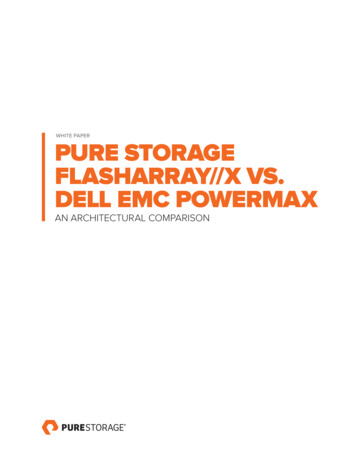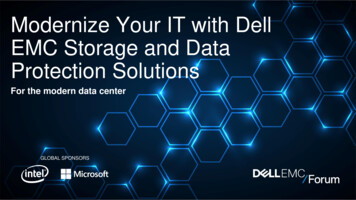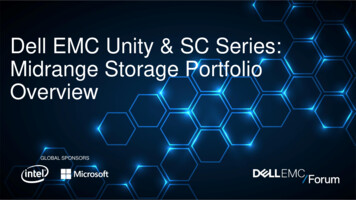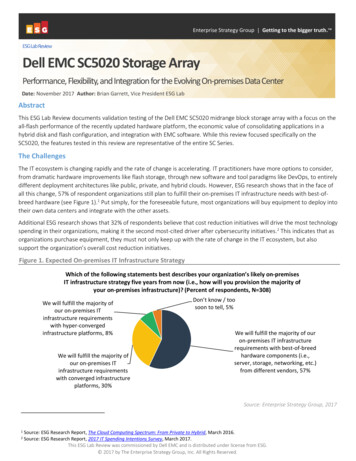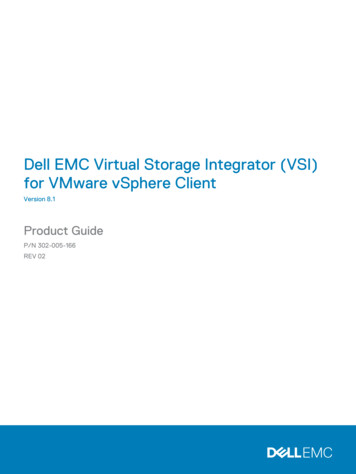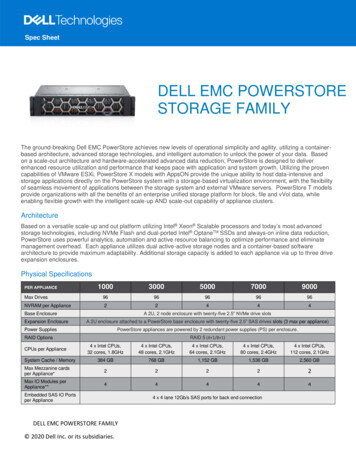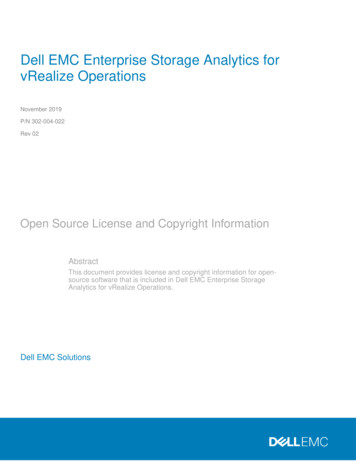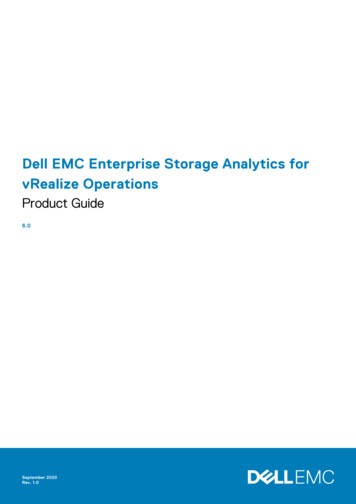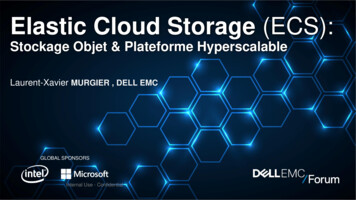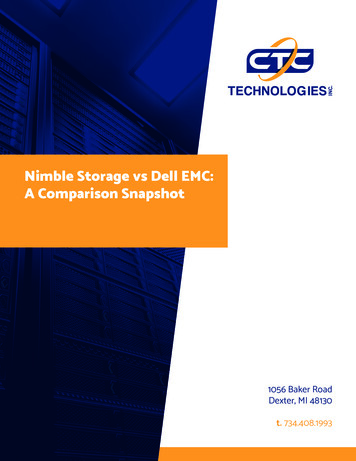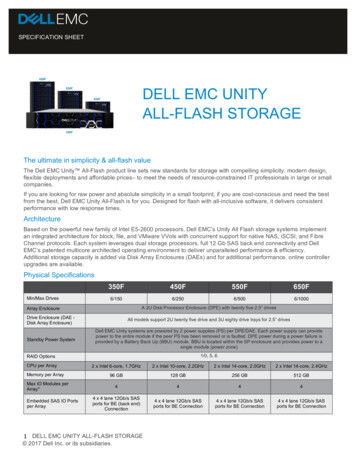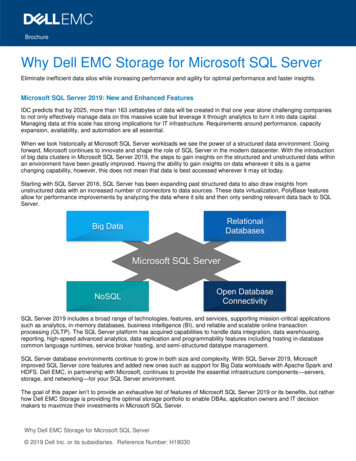
Transcription
BrochureWhy Dell EMC Storage for Microsoft SQL ServerEliminate inefficient data silos while increasing performance and agility for optimal performance and faster insights.Microsoft SQL Server 2019: New and Enhanced FeaturesIDC predicts that by 2025, more than 163 zettabytes of data will be created in that one year alone challenging companiesto not only effectively manage data on this massive scale but leverage it through analytics to turn it into data capital.Managing data at this scale has strong implications for IT infrastructure. Requirements around performance, capacityexpansion, availability, and automation are all essential.When we look historically at Microsoft SQL Server workloads we see the power of a structured data environment. Goingforward, Microsoft continues to innovate and shape the role of SQL Server in the modern datacenter. With the introductionof big data clusters in Microsoft SQL Server 2019, the steps to gain insights on the structured and unstructured data withinan environment have been greatly improved. Having the ability to gain insights on data wherever it sits is a gamechanging capability, however, this does not mean that data is best accessed wherever it may sit today.Starting with SQL Server 2016, SQL Server has been expanding past structured data to also draw insights fromunstructured data with an increased number of connectors to data sources. These data virtualization, PolyBase featuresallow for performance improvements by analyzing the data where it sits and then only sending relevant data back to SQLServer.RelationalDatabasesBig DataMicrosoft SQL ServerNoSQLOpen DatabaseConnectivitySQL Server 2019 includes a broad range of technologies, features, and services, supporting mission-critical applicationssuch as analytics, in-memory databases, business intelligence (BI), and reliable and scalable online transactionprocessing (OLTP). The SQL Server platform has acquired capabilities to handle data integration, data warehousing,reporting, high-speed advanced analytics, data replication and programmability features including hosting in-databasecommon language runtimes, service broker hosting, and semi-structured datatype management.SQL Server database environments continue to grow in both size and complexity. With SQL Server 2019, Microsoftimproved SQL Server core features and added new ones such as support for Big Data workloads with Apache Spark andHDFS. Dell EMC, in partnership with Microsoft, continues to provide the essential infrastructure components—servers,storage, and networking—for your SQL Server environment.The goal of this paper isn’t to provide an exhaustive list of features of Microsoft SQL Server 2019 or its benefits, but ratherhow Dell EMC Storage is providing the optimal storage portfolio to enable DBAs, application owners and IT decisionmakers to maximize their investments in Microsoft SQL Server.Why Dell EMC Storage for Microsoft SQL Server 2019 Dell Inc. or its subsidiaries. Reference Number: H18030
The right data, in the right place, at the right SLAIDC predicts that by 2025, more than 163 zettabytes of data will be created in that one year alone challenging companiesto not only effectively manage data on this massive scale but leverage it through analytics to turn it into data capital.Managing data at this scale has strong implications for IT infrastructure. Requirements around performance, capacityexpansion, availability, and automation are all essential.When we look historically at Microsoft SQL Server workloads we see the power of an efficiently structured dataenvironment. Going forward, Microsoft continues to innovate and shape the role of SQL Server in the modern datacenter.With the introduction of big data clusters in Microsoft SQL Server 2019, the steps to gain insights on the structured andunstructured data within an environment have been greatly improved. Having the ability to gain insights on data whereverit sits is a game changing capability, however, this does not mean that data is best accessed wherever it may sit today.For the past few years, the migration to flash storage from spinning disk has been a major focus in the enterprise datacenter as exabytes (EB) of data have been migrated from spinning disk to flash storage. The eventuality of this migrationshould not have been surprising as the potential performance gains offered by flash storage are orders of magnitudegreater than that of spinning disk.Consolidation for Optimized Microsoft SQL Server EnvironmentsDell Technologies is leading the modernization of the datacenter withDell EMC storage solutions that allow for the consolidation of data onplatforms designed for 99.9999% of availability, sub-millisecondsustained latency, maximum agility, and superior security. Optimizingthe underlying infrastructure for Microsoft SQL Server not only benefitsthe storage administrators; it also has a significant impact on theeffective agility of DBAs leveraging these arrays.The reality for most companies is that their Microsoft SQL Serverenvironments span many different versions which have disparatefeatures and capabilities. Consolidation of these versions on to amodern active-active all-flash array allows for the offloading ofresponsibilities to the infrastructure and helps to provide a moreconsistent and elevated experience to all versions. The benefits that areexperienced are largely based on the data services provided by thearray and these are highly differentiated across the industry with respectto the performance impact and effectiveness of the data services.Modern Array Data ServicesIn an all-flash environment there is alwayssignificant focus on the effective capacity of thearray to maximize efficiency and TCO. Whilecreating these efficiencies of how data is storedon an array, a side effect is unparallel agility foryour SQL Server environment. Across the DellEMC storage product portfolio there are alsoseveral key differentiators and variations onfeatures; this section will focus on thecommonalities of Dell EMC primary storagearrays.For the purpose of this paper, those include DellEMC Unity XT, PowerMax, XtremIO X2 and SC.
Usable Capacity: An often-overlooked aspect is the impact of system overhead, or lack thereof, that themanagement, monitoring and the underlying RAID create. Dell EMC arrays provide some of the highestusable capacity in the industry with systems providing as much as 88% usable capacity to the servers.Thin Provisioning: Commonplace today, this is one of the key features for maximizing the costeffectiveness of a shared storage environment. For a DBA, this allows them to allocate the database filesto the expected size in the future and not have to increase the size of it later. Space is only consumed asthe data is written to the arrayCompression: While this is done in slightly different ways on the Dell EMC portfolio of storage arrays,each system typically will provide better than 2:1 compression on a database that is not alreadyleveraging row or page compression within Microsoft SQL Server. Relying solely on the storage array toprovide compression often can result in the improvement of performance due to the freeing up of SQLServer CPU resources. Testing should be done in all cases, however, since the impact can varydepending on workload.Deduplication: There are many reasons a DBA or application owner would need to create databasecopies. Test/Dev, patch testing, near real-time analytics, or just making a copy for protection, thesedatabase copies will be 100% deduplicated on the array. Only the delta unique changes that are made tothe copies or production will result in new data being written to the array.Intelligent Snapshots: As efficient as deduplication is, an even more efficient and faster way to make adatabase copy is to simply take a snapshot of a volume or set of volumes and mount the snapshots to aSQL Server instance. Making database copies in this way ensures little to no impact to the productiondatabase and allows copies of even very large (20TB ) databases to be provided in under 5 minutes.D@RE: Data at Rest Encryption ensures that all sensitive user data stored on array is encrypted whenbeing written to disk, so that private data does not fall into the wrong hands. With simple activation,management, and auditing functionality, D@RE is a powerful tool to protect data, regardless of anorganization’s size, industry, or use case.Replication: Array-based replication of Microsoft SQL Server databases can easily co-exist with databasereplicas created by AlwaysOn Availability Groups. This replication offloads burden from SQL Server tomanage the replication without impact to the host. It also allows you a single method of replication that isconsistent regardless of the Microsoft SQL version.QoS: Quality of Service, even in the world of all flash arrays, can play an important role to easing theconcerns of some organizations to take advantage of consolidation of production, test/dev, analytics andmore.iCDM: Integrated Copy Data Management for Microsoft SQL ServerWith all those great data services as a foundation, we can now focus on one of the biggest issues facing a databaseenvironment. Copies of production databases are required by many different stakeholders and they want them fordifferent reasons: Developers use copies as source for the next iteration of the application, to help identify and fix bugs incurrent applications.All applications need to be backed up at some point, so data protection copies are required.Reporting functions need copies to enable better business decisions.Copies enable businesses to allow these functions to run in parallel without interfering with production processing.
iCDM addresses copy management use cases in aconsolidated SQL database environment for databaseprotection, recovery and database repurposing. Dell EMCAppSync automatically discovers application databases,learns the database structure, and maps it through thevirtualization layer to the underlying Dell EMC storage.With copies of databases being provisioned so easily viasnapshots, consolidation of production and test/devenvironments on the same all flash array can providesignificant benefits. Dell EMC AppSync simplifies,orchestrates, and automates the process of generating andconsuming application consistent copies of production data.AppSync’s deep application integration coupled withabstraction of underlying Dell EMC storage and replicationtechnologies empowers application owners to satisfy copydemands for data repurposing, operational recovery anddisaster recovery, all from a single user interface. Simple: Automated copy management without the need for custom scripts. Intelligent: Tight integration with applications, hosts, virtualization, Dell EMC storage and replicationenvironments. Frictionless: DBAs, applications owners and storage admins are on the same page with a transparent copyworkflowAppSync orchestrates all the activities required, from copy creation and validation through mounting the snapshots at thetarget host and launching or recovering the application. This solution supports and simplifies Microsoft SQL Serverworkflows that include refreshing and expiring copies as well as restoring the production database.In addition to the orchestration options, iCDM allows Test/Dev engineers to be able to refresh their environment from thelatest gold master copy of the database in an ad-hoc fashion whenever they need to do so. This results in accelerateddevelopment and optimization of the data reduction rate of the array since only the unique data blocks that are deltasbetween production, gold master, and the additional copies will result in storage growth.How Do Containers Change the Landscape?To improve competitiveness in a fast-paced world, organizations are embracing software as a prime differentiator. Asoftware-driven business is more agile and efficient, innovates faster and responds dynamically to changing market andcustomer demands. Increasingly, gaining these compelling advantages requires adopting cloud-native applications. Thebenefits of containerized Microsoft SQL Server lie in the efficient provisioning, startup times, DevOps improvements, andbeing able to significantly reduce the overall storage capacity versus a VM.Kubernetes is the de facto standard for container orchestration for microservices and applications. However, enterpriseadoption of big data and databases using containers and Kubernetes is hindered by multiple challenges, such ascomplexity of persistent storage, availability, and application life-cycle management. Kubernetes provides the agility andscale that modern enterprises require. However, Kubernetes provides the building blocks for infrastructure, but not aturnkey solution.Originally containers and Kubernetes were optimized for stateless applications, restricting enterprises to use containertechnology for workloads, such as websites and user interfaces. More recently, stateful workloads have been increasinglyrun on Kubernetes. Whereas it is relatively easy to run stateless microservices using container technology, statefulapplications require slightly different treatment.
Container technology enables Microsoft SQL Server development teams to quickly provision isolated applications withoutthe traditional complexities. For many companies, the use of containers starts with the departments that are focused onsoftware development, to boost productivity and time to value. The journey typically starts with installing, implementing, andusing containers for applications that are based on the microservice architecture.Whether customers are looking to use containers for test and development purposes, like DevOps, or to deploydatabases with container orchestrators such as Kubernetes, SQL Server in containers ensures a consistent, isolated andreliable behavior across environments, that is easy to use, start and stop. Customized content can be built on top of SQLServer containers, and run without being affected by the rest of the environment. This isolation makes SQL Server incontainers ideal for test deployment scenarios as well as DevOps processes.Dell EMC CSI SupportContainers are ephemeral by nature, so the data that needs to be persistent must survive through the restart/rescheduling of a container. When containers are rescheduled, they can die on one host, and might get scheduled on adifferent host. In such cases, the storage should also be shifted and made available on a new host for the container tostart gracefully. This is functionality is delivered via the CSI plugin.Dell EMC brings the power of persistent storage to a stateless platform. Dell EMC’s storage and CSI plug-ins enablecontainer orchestrators, like Kubernetes, to easily provision highly available and scalable container volumes for statefulcontainerized applications and databases. CSI driver capabilities are constantly being improved upon so, be sure toleverage the latest version and follow along with updates on GitHub.com/Dell.How Big Data Clusters change the gameOne of the most exciting new capabilities with the release of Microsoft SQL Server2019 is Big Data Clusters. Big Data Clusters leverage containers and allow you tocombine high-value data and high-volume data together into a single platformpowered by SQL Server and other industry leading technologies such as HDFS andSpark. With multiple data formats, multiple sources, and increased data capacityand analytics capabilities, storage is more critical than ever.Big Data Clusters allow existing SQL Server skillsets, like knowledge of T-SQL, tobe used to query data that may exist in structured data sources such as Oracle and
SQL Server together with unstructured data. Silos of data that exist in the datacenter can be taken advantage of now viaAzure Data Studio whether data sits on-premises or in the cloud.The impact that this will have for businesses seeking to gain faster insights on their data is enormous. While somereporting processes still may require intensive ETL process, this allows for a fine tuning of data access through thesharded implementation where limited data is transferred, and insights are drawn closer to the source of the data.Protecting Big Data ClustersBig Data solutions are relatively new and while they are many different combinations and deployments, most face acommon issue. The amount of data stored in these environments is in the terabytes to petabytes, but backup andrecovery is often an afterthought. The size of the data combined with multiple sources can make them a real challenge tobackup and recover. Common data protection strategies include rebuilding and rehydrating the big data environment, ormaintaining parallel copies, both of which can be costly and time-consuming. As these Big Data Solutions becomeincreasingly critical to business, the availability requirements will inevitably increase making these strategiesunacceptable.The storage snapshot capabilities of Dell EMC storage allow these environments to be protected by storage snapshots ina matter of seconds, allowing for fast, efficient point-in-time copies, and recovery times in minutes, not days or months.No Compromise Mid-Range Storage for Microsoft SQL ServerDell EMC Unity XT arrays combine compellingsimplicity, all-inclusive software, blazing speed,optimized efficiency, and multi-cloud enablement tomeet the needs of resource-constrained ITprofessionals in large or small companies. Designedfor performance, optimized for efficiency and built forhybrid cloud environments, these systems are theperfect fit for supporting demanding virtualizedapplications, deploying unified storage andconsolidating SQL Server environments.Simplify the Data LandscapeMicrosoft SQL Server’s storage can be rightsized forperformance, capacity and price at initial deploymentand scale to meet future needs. Inline dataefficiencies lower TCO while integrated copy data management provides orchestration and self-service for DBAs. DellEMC’s Unity XT is a scale-up architecture, available in variety of models to meet the needs for Microsoft SQL Serverdatabase deploymentsDell EMC Unity XT is as simple and easy to install as a consumer networked printer, increasing productivity. Simplifydatabase storage management with an intuitive interface and leading virtualization integrations to support Microsoft SQLdeployments. It only takes 25 minutes from opening the box until the Dell EMC Unity XT array is configured and ready todeliver operational productivity. As databases grow, capacity expansion is simple, scalable in increments as small as just2 drives. Dell EMC Unity XT systems are 85% efficient and deliver up to 790TB effective capacity per rack unit.Today’s reporting processes require actionable insight to be drawn from a variety of data sources. Dell EMC Unity XT isboth a block and file platform, allowing for the consolidation of the valuable data required for modern reporting with SQLServer Analysis Services.Optimized Performance & Data ServicesDell EMC Unity XT is the simple, modern, flexible, and affordable storage solution for IT organizations looking toconsolidate their Microsoft SQL Server database applications. Dell EMC Unity XT’s architecture supports scores of VMswhile delivering abundant IOPS at sustained low latency ( 1ms) for running demanding Microsoft SQL workloads.Dell EMC Unity XT combines inline compression and inline deduplication which combine to provide up to 5:1 datareduction with high resource efficiency that lowers TCO. Leveraging compression on the array instead of row or pagecompression at the database level can help improve CPU utilization and improve performance.
Rest Easy with Highly Certified StorageAll DBAs are diligently concerned with the overall security of their data, in-flight and at rest. Dell EMC Unity XT eases thisconcern, as it is Dell EMC’s most federally certified storage and is on the US DoD approved products list. Dell EMC Unit
SQL Server 2019 includes a broad range of technologies, features, and services, supporting mission-critical applications such as analytics, in-memory databases, business intelligence (BI), and reliable and scalable online transaction . Intelligent Snapshots: As efficient as deduplic
